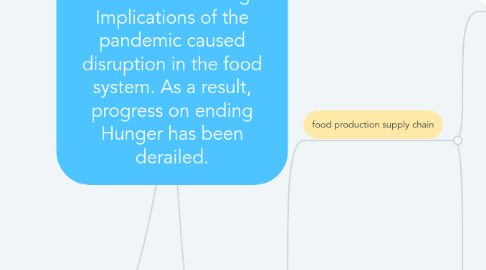
1. non gov action (first responders)
1.1. Logistics
1.1.1. support food distribution, provision of water/sanitation services, rehabilitation, and construction.
1.1.2. support procurement planning, purchasing of goods and services, transport and storage sytsem
1.2. Emergency response
1.2.1. Treat and prevent the direct causes of malnutrition, like inadequate diets and poor knowledge of feeding practices
1.2.1.1. adaptative technology
1.2.1.1.1. simple, easy to use app to share nutrition info, good recipes using local ingredients, best cooking practices etc
1.3. Voucher distribution
1.3.1. Adaptative technology
1.3.1.1. simple, easy to use app to sign for food
1.4. vulnerability mapping
1.4.1. targeting young children, pregnant women, breastfeeding mothers and people living with HIV.
2. Gov action
2.1. food production supply chain
2.1.1. Rural area
2.1.1.1. Production
2.1.1.1.1. Smallholder farmers
2.1.1.1.2. Industry /retailers
2.1.1.1.3. "big farms"and conglomerates
2.1.1.2. logistic/transport
2.1.1.2.1. Purchase extra stock from local and regional food suppliers and growers
2.1.1.2.2. Provide transportation support that allows producers to get products to market or community food warehousesDuring
2.1.1.3. marketing
2.1.2. Urban area
2.1.2.1. production
2.1.2.2. logistic/transport
2.1.2.3. marketing
2.1.2.3.1. Implement a price freeze on staple and nutritious food items
2.1.2.3.2. Organize food voucher programs with local shopkeepers that allow at-risk households to obtain food in exchange for a voucher
2.1.2.3.3. Organize fair price shops that sell basic items at controlled prices
2.1.2.4. financial aid
2.1.2.4.1. short-term debt relief programs
2.1.2.4.2. low-cost credit arrangements
2.2. people
2.2.1. health
2.2.1.1. Distribute vitamin supplements
2.2.1.2. Implement contingency plan to maintain essential services such as water, power, and basic sanitation during a severe pandemic
2.2.1.3. promote healthy eating and physical activity in the context of social isolation.
2.2.2. nutrition
2.2.2.1. municipality acquire foods for community stockpiles to meet the nutritional energy needs of populations when they are combined into food baskets for distribution
2.2.2.2. delivery of school food kits directly to students despite the closure of schools
2.2.3. social protection
2.2.3.1. Elderly, unemployed, pregnant/lactating women and children below two years of age.
2.2.3.1.1. Distribute food to the most vulnerable residents in a way that minimizes contact between people when social distancing measures are in place
2.2.3.1.2. Deliver food and water to isolated households and individuals
2.2.3.1.3. observation, monitoring, and treatment of child malnutrition
2.2.3.1.4. exemption from payment of energy bills (hydro)
2.2.4. financial aid
